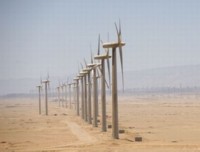Winds of change: electricity from wind in the Middle East
 In the airless heat of the Gulf, it is hard to imagine the Middle East proving a worthwhile location for wind power producers. Considering its plentiful year-round sunshine, it is not surprising that solar projects tend to attract the most attention in the region.
In the airless heat of the Gulf, it is hard to imagine the Middle East proving a worthwhile location for wind power producers. Considering its plentiful year-round sunshine, it is not surprising that solar projects tend to attract the most attention in the region.But those countries in the Middle East with sufficient wind capacity are making headway beyond solar. And Middle East wind developments are perhaps not as counterintuitive as they first appear - as visitors to the 2012 World Future Energy Summit will testify, not to mention last year’s winner of the Zayed Future Energy Prize: Danish wind turbine leader, Vestas.
Wind offers a solution to the growing power requirements of countries without significant oil and gas resources, and is one of the few renewable energy technologies that require very little water in order to operate, a critical consideration in the arid Middle East.
Egypt, which perhaps has the best wind profile in the region, has already installed capacity of 400 megawatts, a figure it hopes to increase to 7,200 megawatts by 2020.
In Lebanon, which currently imports all of its fuel needs, the government is researching a national wind atlas to pinpoint the best locations for development and encourage private investment.
Jordan wants 10 per cent of its electricity to come from renewable sources by 2020, including at least 600 megawatts from wind.
Even Iran is setting a positive example in the wind sector, with 100 megawatts of capacity installed to date.
Political will and capital are clearly needed to help diversify the Middle East’s renewable energy mix, challenges that will be addressed at both the exhibition and conference of next January’s World Future Energy Summit.
The fact that developing countries like China and India are ramping up capacity in wind power demonstrates the global opportunities in the sector, and offers encouragement to decision makers in the Middle East.
In the coming decades, wind power in the region may amount to a great deal more than hot air.
Source: wfesblog.org
You can return to the main Market News page, or press the Back button on your browser.

